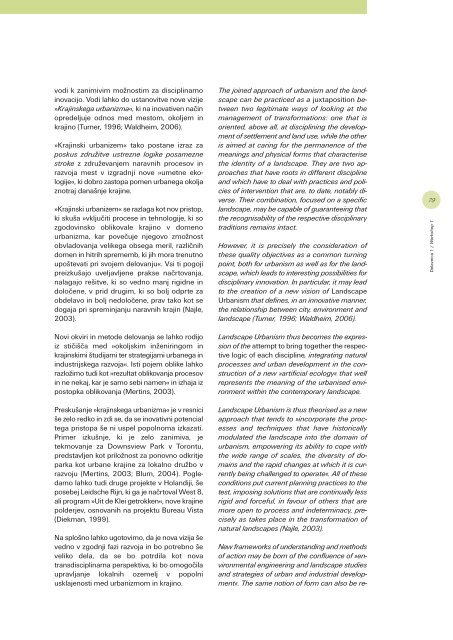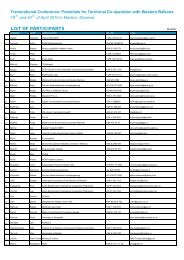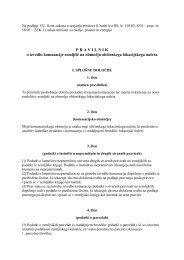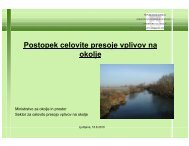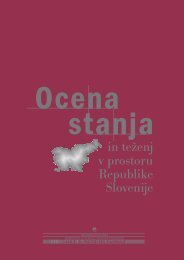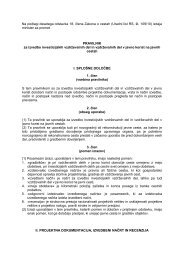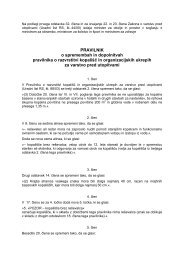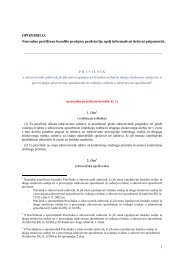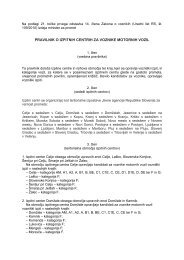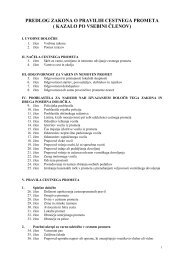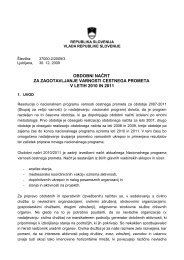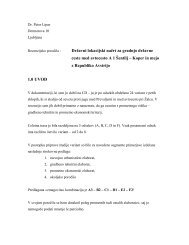evropska konvencija o krajini - Ministrstvo za infrastrukturo in prostor
evropska konvencija o krajini - Ministrstvo za infrastrukturo in prostor
evropska konvencija o krajini - Ministrstvo za infrastrukturo in prostor
You also want an ePaper? Increase the reach of your titles
YUMPU automatically turns print PDFs into web optimized ePapers that Google loves.
vodi k <strong>za</strong>nimivim možnostim <strong>za</strong> discipl<strong>in</strong>arno<strong>in</strong>ovacijo. Vodi lahko do ustanovitve nove vizije»Kraj<strong>in</strong>skega urbanizma«, ki na <strong>in</strong>ovativen nač<strong>in</strong>opredeljuje odnos med mestom, okoljem <strong>in</strong>kraj<strong>in</strong>o (Turner, 1996; Waldheim, 2006).»Kraj<strong>in</strong>ski urbanizem« tako postane izraz <strong>za</strong>poskus združitve ustrezne logike posameznestroke z združevanjem naravnih procesov <strong>in</strong>razvoja mest v izgradnji nove »umetne ekologije«,ki dobro <strong>za</strong>stopa pomen urbanega okoljaznotraj današnje kraj<strong>in</strong>e.»Kraj<strong>in</strong>ski urbanizem« se razlaga kot nov pristop,ki skuša »vključiti procese <strong>in</strong> tehnologije, ki sozgodov<strong>in</strong>sko oblikovale kraj<strong>in</strong>o v domenourbanizma, kar povečuje njegovo zmožnostobvladovanja velikega obsega meril, različnihdomen <strong>in</strong> hitrih sprememb, ki jih mora trenutnoupoštevati pri svojem delovanju«. Vsi ti pogojipreizkušajo uveljavljene prakse načrtovanja,nalagajo rešitve, ki so vedno manj rigidne <strong>in</strong>določene, v prid drugim, ki so bolj odprte <strong>za</strong>obdelavo <strong>in</strong> bolj nedoločene, prav tako kot sedogaja pri sprem<strong>in</strong>janju naravnih kraj<strong>in</strong> (Najle,2003).Novi okviri <strong>in</strong> metode delovanja se lahko rodijoiz stičišča med »okoljskim <strong>in</strong>ženir<strong>in</strong>gom <strong>in</strong>kraj<strong>in</strong>skimi študijami ter strategijami urbanega <strong>in</strong><strong>in</strong>dustrijskega razvoja«. Isti pojem oblike lahkorazložimo tudi kot »rezultat oblikovanja procesov<strong>in</strong> ne nekaj, kar je samo sebi namen« <strong>in</strong> izhaja izpostopka oblikovanja (Mert<strong>in</strong>s, 2003).Preskušanje »kraj<strong>in</strong>skega urbanizma« je v resniciše zelo redko <strong>in</strong> zdi se, da se <strong>in</strong>ovativni potencialtega pristopa še ni uspel popolnoma izka<strong>za</strong>ti.Primer izkušnje, ki je zelo <strong>za</strong>nimiva, jetekmovanje <strong>za</strong> Downsview Park v Torontu,predstavljen kot priložnost <strong>za</strong> ponovno odkritjeparka kot urbane kraj<strong>in</strong>e <strong>za</strong> lokalno družbo vrazvoju (Mert<strong>in</strong>s, 2003; Blum, 2004). Pogledamolahko tudi druge projekte v Holandiji, šeposebej Leidsche Rijn, ki ga je načrtoval West 8,ali program »Uit de Klei getrokken«, nove kraj<strong>in</strong>epolderjev, osnovanih na projektu Bureau Vista(Diekman, 1999).Na splošno lahko ugotovimo, da je nova vizija ševedno v zgodnji fazi razvoja <strong>in</strong> bo potrebno ševeliko dela, da se bo potrdila kot novatransdiscipl<strong>in</strong>arna perspektiva, ki bo omogočilaupravljanje lokalnih ozemelj v popolniusklajenosti med urbanizmom <strong>in</strong> kraj<strong>in</strong>o.The jo<strong>in</strong>ed approach of urbanism and the landscapecan be practiced as a juxtaposition betweentwo legitimate ways of look<strong>in</strong>g at themanagement of transformations: one that isoriented, above all, at discipl<strong>in</strong><strong>in</strong>g the developmentof settlement and land use, while the otheris aimed at car<strong>in</strong>g for the permanence of themean<strong>in</strong>gs and physical forms that characterisethe identity of a landscape. They are two approachesthat have roots <strong>in</strong> different discipl<strong>in</strong>eand which have to deal with practices and policiesof <strong>in</strong>tervention that are, to date, notably diverse.Their comb<strong>in</strong>ation, focused on a specificlandscape, may be capable of guarantee<strong>in</strong>g thatthe recognisability of the respective discipl<strong>in</strong>arytraditions rema<strong>in</strong>s <strong>in</strong>tact.However, it is precisely the consideration ofthese quality objectives as a common turn<strong>in</strong>gpo<strong>in</strong>t, both for urbanism as well as for the landscape,which leads to <strong>in</strong>terest<strong>in</strong>g possibilities fordiscipl<strong>in</strong>ary <strong>in</strong>novation. In particular, it may leadto the creation of a new vision of LandscapeUrbanism that def<strong>in</strong>es, <strong>in</strong> an <strong>in</strong>novative manner,the relationship between city, environment andlandscape (Turner, 1996; Waldheim, 2006).Landscape Urbanism thus becomes the expressionof the attempt to br<strong>in</strong>g together the respectivelogic of each discipl<strong>in</strong>e, <strong>in</strong>tegrat<strong>in</strong>g naturalprocesses and urban development <strong>in</strong> the constructionof a new »artificial ecology« that wellrepresents the mean<strong>in</strong>g of the urbanised environmentwith<strong>in</strong> the contemporary landscape.Landscape Urbanism is thus theorised as a newapproach that tends to »<strong>in</strong>corporate the processesand techniques that have historicallymodulated the landscape <strong>in</strong>to the doma<strong>in</strong> ofurbanism, empower<strong>in</strong>g its ability to cope withthe wide range of scales, the diversity of doma<strong>in</strong>sand the rapid changes at which it is currentlybe<strong>in</strong>g challenged to operate«. All of theseconditions put current plann<strong>in</strong>g practices to thetest, impos<strong>in</strong>g solutions that are cont<strong>in</strong>ually lessrigid and forceful, <strong>in</strong> favour of others that aremore open to process and <strong>in</strong>determ<strong>in</strong>acy, preciselyas takes place <strong>in</strong> the transformation ofnatural landscapes (Najle, 2003).New frameworks of understand<strong>in</strong>g and methodsof action may be born of the confluence of »environmentaleng<strong>in</strong>eer<strong>in</strong>g and landscape studiesand strategies of urban and <strong>in</strong>dustrial development«.The same notion of form can also be re-79Delavnica 1 / Workshop 1


